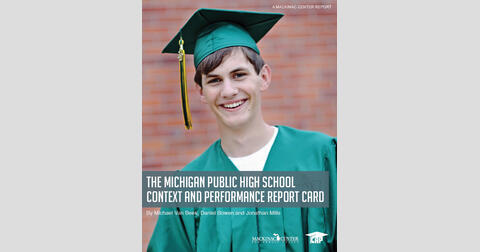New Report Card Compares High School Test Scores and Adjusts For Economic Status
'Apples-to-apples' comparison provides true measure for parents
The problem with measuring school districts has always been the trouble of making "apples-to-apples" comparisons for student achievement.
For example, it is well-known that the students attending Detroit Public Schools have a low high school graduation rate and have scored poorly on standardized tests. But are these poor results because of the teachers and administrators in those schools? Or because the students being tested are from low-income households?
For a long time, citizens and policymakers in Michigan have had a hard time knowing how well schools are actually educating their students. Until now.
The Mackinac Center for Public Policy has released its “Michigan Public High School Context and Performance Report Card” or “CAP.” The CAP Report Card examines public high school performance while taking into account family income, producing an “apples-to-apples” comparison for parents and policymakers.
"Education research consistently shows that socioeconomic factors have a significant impact on standardized test results," said Michael Van Beek, the Center’s director of education policy and co-author of the report card. "This is the first-of-its-kind attempt in Michigan to take this reality into account, and it helps us identify outstanding schools that by most measures would appear mediocre."
In short, the CAP Report Card takes Michigan Merit Exam and ACT test scores and adjusts them based on the percentage of students in the school who qualified for free or reduced-price lunch. A "CAP Score" indicates how far above and below expectations a high school performed based on the socioeconomic status of its student population. If the CAP Score for a school was above 100 the school exceeded the statewide average; if below 100, the school fell short.
For example, students at Star International Academy, a charter school in Dearborn Heights, score around the state average on tests. But since about 90 percent of the school’s students are from low-income households, the CAP Score for the school is 140.8 — the highest in the state.
At the other end of the scale are many high schools in the Detroit Public Schools system. Of the 35 public high schools in Detroit, 25 received D's or F's, which means they score among the lowest 20 percent of schools.
Of the top 6 best-performing high schools, four were charter schools and two were public schools that can selectively choose their students. The top-performing conventional public high school in the state was North Huron School. To see a list of the top 20 best-performing high schools, click here. To see a list of the top 25 best-performing conventional high schools, click here.
More than half of the top 20 worst-performing high schools were in Detroit, as well as five of the top six. Six of the 20 worst performers were charter schools. To see a list of the 20 worst-performing high schools, click here. To see a list of the 25 worst-performing conventional high schools, click here.
"The CAP Report Card has useful information for everyone," Van Beek said. "It will enable parents to make informed school choice decisions, provide school officials with a better assessment of their school's performance, and help policymakers identify high-performing schools and practices in an area that makes up the largest single state expenditure."
Jonathan Mills and Daniel Bowen of the University of Arkansas co-authored the study with Van Beek. The full report card and a fuller explanation of the study is available online at www.mackinac.org/CAP.
Michigan Capitol Confidential is the news source produced by the Mackinac Center for Public Policy. Michigan Capitol Confidential reports with a free-market news perspective.

